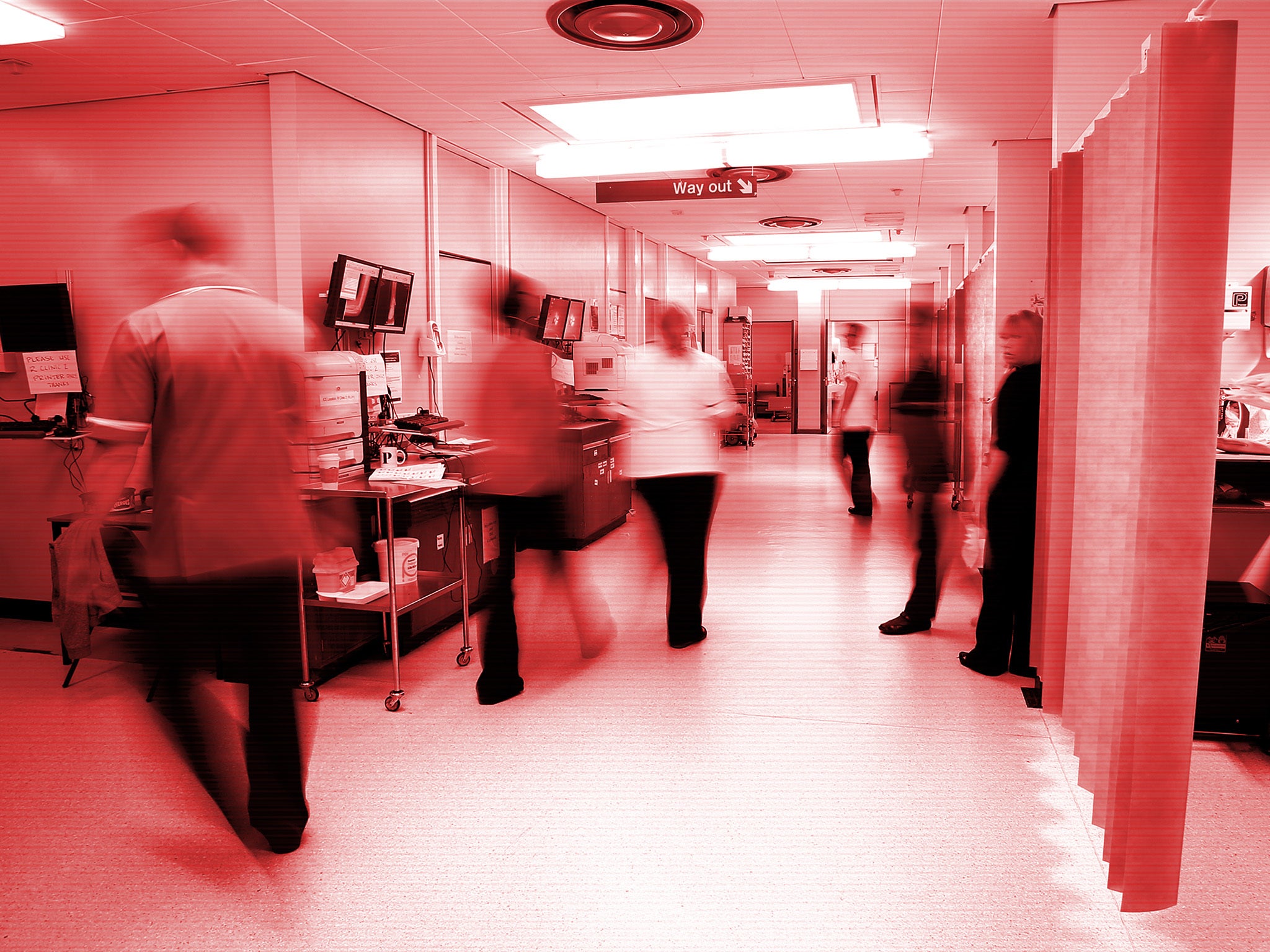Eight days waiting in A&E: Inside the crisis in NHS mental health care
From counselling and community care to emergency departments, every level of NHS mental health services is on the brink – and it’s patients who are suffering. Health correspondent Rebecca Thomas uncovers how close the system is to collapse


Your support helps us to tell the story
From reproductive rights to climate change to Big Tech, The Independent is on the ground when the story is developing. Whether it's investigating the financials of Elon Musk's pro-Trump PAC or producing our latest documentary, 'The A Word', which shines a light on the American women fighting for reproductive rights, we know how important it is to parse out the facts from the messaging.
At such a critical moment in US history, we need reporters on the ground. Your donation allows us to keep sending journalists to speak to both sides of the story.
The Independent is trusted by Americans across the entire political spectrum. And unlike many other quality news outlets, we choose not to lock Americans out of our reporting and analysis with paywalls. We believe quality journalism should be available to everyone, paid for by those who can afford it.
Your support makes all the difference.People suffering from mental illness are increasingly struggling to access help at every level of the NHS – from record numbers facing “unacceptable” delays in referrals to patients waiting up to eight days in A&E for a hospital bed.
Figures seen by The Independent show almost four times as many people are waiting more than 12 hours in emergency departments as two years ago.
In the community, more than 16,000 adults and 20,000 children who should receive NHS care are unable to access vital services each month.
Nearly 80 per cent of those eligible for counselling on the health service are left waiting more than three months for a second appointment, which is when treatment usually begins.
Health leaders say they are “deeply concerned” by the lack of resources available to handle the rise in demand – and warned that the cost of living crisis would exacerbate the issue further.
A mattress on the emergency department floor
Monica Smith went to A&E at Lewisham last month after her mental health deteriorated when her medication ran out and she was unable to get more.
The 32-year-old said: “I was told, ‘We can’t find any beds – there’s no bed in the whole country or the whole region, so we’re going to have a bed on A&E and hopefully you’ll get a bed in the morning.’”
Monica started hallucinating and was given medication to calm her down, but in the morning there was still no bed. Doctors tried to send her home, she said, but crisis services assessed her three times over the following days and each time decided she was too unwell.
Instead, Monica stayed in an annex off A&E with other mental health patients. She said: “I was on this, like, mattress, like a mental health mattress on the floor.”
It took almost eight days for her to be moved out of A&E and onto a ward.
South London and Maudsley NHS Trust, which runs mental health services in the area, said there was high demand for beds but it had increased capacity. Lewisham and Greenwich Trust said it has no option but to keep patients in A&E while waiting for beds.
Long waits for mental health patients in crisis are echoed in emergency departments across the country. Internal NHS data shows that, at the end of last month, one in four mental health patients in A&E had to wait more than 12 hours to be seen – a far higher proportion than those waiting for emergency physical care.
The wait to actually be given a bed can be far longer; in September, the Royal College of Emergency Medicine published a briefing in which doctors reported waits of 15 and 20 days.
Shadow mental health minister Dr Rosena Allin-Khan told The Independent: “No one should find themselves stuck in a mental health crisis in emergency departments because they are unable to access vital treatment. Without access to timely treatment, mental illnesses only worsen.”
Have you been affected by these issues? email rebecca.thomas@independent.co.uk
These 12-hour waits topped 5,000 in August – rising from less than 1,500 two years earlier, despite the overall number of emergency admissions remaining relatively stable.
Saffron Cordery, of NHS Providers, which represents hospital bosses, said: “Trust leaders are deeply concerned by the ongoing mismatch between capacity and demand for mental health services, which can result in a lack of treatment in the right local setting and unacceptably long waits.”
She said the impact of the cost of living crisis – increasing stress, debt and poverty – had already led to a 72 per cent rise in demands on trusts.
The struggle to even get a diagnosis
The crisis is exacerbated by community services that cannot intervene before cases become so serious that emergency care is required.
Neil Anthony Murphy, a senior community mental health nurse from Manchester who retired in June, said teams were constantly “firefighting”, finding patients were often too unwell for short-term services, known as IAPT (which stands for Improving Access to Psychological Therapies), but could not receive care from community mental health teams.
I don’t know where to go for help
He said: “Community mental health teams are not a sponge that can absorb everything. Patients deteriorate to the point where you’ve been referred to a service, it’s already quite poor and then you’re told you’re on a waiting list. You’re just going to get worse and end up in crisis… so they’re being told the only place you can go is A&E.”
Referrals to community services have increased by 30 per cent since the pandemic, according to the NHS.
Data obtained by The Independent shows that, since March, the NHS has missed its own targets for the number of patients who should receive care from NHS community mental health teams by 16,000 a month. For children, the average is 20,000.
The actual number of patients not getting care could be even higher as the data does not detail the total number of referrals it receives each month.
For many patients needing NHS counselling it means they may have received little more than an initial phone call in more than three months. Thousands every month have not even had that.
Nineteen-year-old Natasha, whose name has been changed, has been struggling to access community mental health care in the east of England since she was diagnosed with severe depression and anxiety at 13, her mother told The Independent. Last year, she was told she could not be offered any treatment as she had completed the only course of therapy available.
96%
of mental health beds occupied in August
Following an attempt by Natasha to take her own life earlier this year, her mother was told there would be an eight-hour wait for an ambulance. “I told the GP, I don’t know where to go for help,” she said. “Nothing’s changed since 2017. We’re terrified that it will get to the point, either that she ends up having to be sectioned or, worse, she has a moment where she is really hurting again, she can’t cope and you know, she does it and it works.”
Despite this, Natasha is still no closer to getting the new diagnosis and medication review her mother says she desperately needs.
Underfunded and understaffed
Behind these rising waiting lists and missed targets is a lack of resources and staff stretched to their limit.
According to an internal NHS briefing document from August, healthcare leaders were warned bed occupancy within mental health trusts was at 96 per cent, well above “safe” levels. Some 70 per cent of the patients waiting to leave hospital could not do so because of a lack of appropriate care available.
On children’s care, the document warned that services met only 27 per cent of demand last year, while bed supply was described as “severely constrained”. A third of the unavailable beds were due to workforce absence.
These services have the chance to make a difference before someone reaches crisis point
Sean Duggan of NHS Confederation, which represents mental health trusts, said: “Demand for mental health support is at an all-time high and continues to rise rapidly, and the knock-on effects of the pandemic on the mental health of the population means that they are under severe pressure and already working beyond capacity in many areas.
“It is high time the government took heed of this strain on mental health services with leaders and their staff still doing all they can as demand continues to skyrocket.”
The NHS admitted the cause of the pressure was “a combination of higher staff absence, issues discharging patients into social care, and increasing numbers of people needing mental health support due to the pandemic”.
But a spokesperson said that £150m had been committed to building alternatives to hospital admission over the next three years. The Department of Health and Social Care said last year an extra £500m was spent on addressing waiting times and expanding talking therapies.
Healthcare leaders and charities have also called on the government to commit to publishing its 10-year mental health strategy with plans to tackle staffing needs across the sector.
Vicki Nash, of mental health charity Mind, said the figures uncovered by The Independent were “a shocking indication of how close our mental health system is to collapsing”.
She said: “These services have the chance to make a difference before someone reaches crisis point – and the failure to do so will mean more people will need intensive support, which inpatient mental health services are not always in the position to deliver in a timely way right now.
“NHS mental health services cannot carry on being underfunded and understaffed. As these figures show, it is simply not sustainable. The UK government must act now, before the problems in our mental health system are beyond repair.”
Join our commenting forum
Join thought-provoking conversations, follow other Independent readers and see their replies
Comments